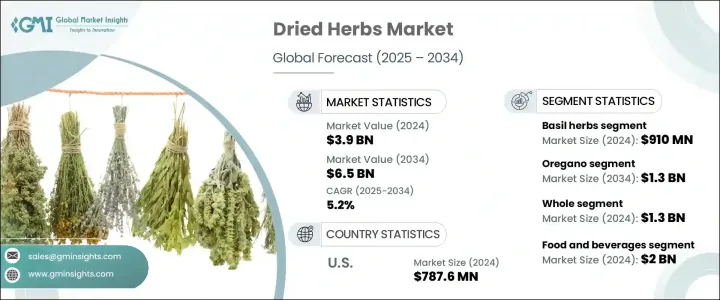
세계 건조 허브 시장은 2024년에 39억 달러로 평가되었으며, 2025년부터 2034년까지 연평균 복합 성장률(CAGR) 5.2%로 성장할 것으로 예상됩니다.
이 성장은 사람들의 건강 지향이 증가함에 따라 천연, 유기농 및 식물 유래 제품에 대한 소비자의 지향이 증가하고 있음을 반영합니다. 소비자가 깨끗한 라벨의 원료를 적극적으로 요구하는 동안, 건조 허브 수요는 요리, 약용 및 개인 관리 응용 분야에서 다목적 사용으로 인해 증가의 길을 따라가고 있습니다. 더 많은 사람들이 건강한 식습관을 채택하고 맛을 향상시킬뿐만 아니라 항산화 물질, 항 염증 특성, 면역 강화 화합물 등 많은 건강상의 이점을 제공하는 허브를 선호합니다. 식물성 식생활에 대한 지속적인 동향은 가정 요리와 미식 요리의 급증과 함께 건조 허브의 소비를 촉진합니다.

게다가 허브티, 영양보조식품, 대체의료의 인기가 높아지면서 시장 수요를 더욱 끌어 올리고 있습니다. 제조 업체 및 소매업체는 인증된 유기농, 비유전자 재조합, 지속 가능한 방식으로 조달된 허브 등 다양한 제품을 제공함으로써 보다 폭넓은 소비자층에 도달할 수 있도록 더 많은 사람들이 건강한 삶과 웰빙에 초점을 맞추고 있기 때문에 고급 품질의 윤리적으로 생산 된 건조 허브에 대한 수요는 예측 기간 동안 꾸준히 증가할 것으로 예상됩니다.
| 시장 범위 | |
|---|---|
| 시작 연도 | 2024년 |
| 예측 연도 | 2025-2034년 |
| 시작 금액 | 39억 달러 |
| 예측 금액 | 65억 달러 |
| CAGR | 5.2% |
건조 허브 시장은 바질, 오레가노, 로즈마리, 타임, 파슬리, 민트, 로리에, 차이브, 고수풀, 딜 등 허브의 유형에 따라 구분됩니다. 그 중 바질은 2024년에 9억 1,000만 달러로 평가되었고 세계 시장을 선도하고 있습니다. 풍부한 향기와 풍미로 알려진 바질은 지중해 요리, 이탈리아 요리, 아시아 요리에 널리 사용되어 더 많은 소비자가 건강하고 유기농인 요리를 받아들이고 있기 때문에 그 인기는 꾸준히 증가하고 있으며, 건조 바질은 가정의 부엌과 상업용 식품 제조에 모두 필수품입니다. 파스타나 피자와 같은 이탈리아 요리와 바질의 결합은 유기농 향신료에 대한 관심 증가와 함께, 특히 소매점과 전자상거래 플랫폼에서 세계 수요를 계속 견인하고 있습니다.
오레가노는 2위의 부문으로, 2024년에는 7억 5,000만 달러에 달했습니다. 오레가노는 그 강한 풍미와 건강 효과로 평가되어 요리나 기능성 식품의 중요한 원료가 되고 있습니다. 유기농 제품과 천연 제품에서의 역할도 확대되고 있습니다. 가정의 부엌에서 상업적인 식품 가공에 이르기까지 소스, 마리네, 조미료 블렌드에 있어서의 오레가노의 사용은 유기농법과 지속 가능한 원료 조달에의 고조되는 동향에 힘입어 성장을 계속하고 있습니다.
미국의 건조 허브 시장은 2024년에 7억 8,760만 달러가 되었으며, 이 나라는 건조 허브의 세계 유수의 소비국이 되었습니다. 허브가 미국의 부엌과 식품 산업을 석권하고 있으며 유기농, 자연, 클린 라벨 제품에 대한 기호 증가가 수요를 견인하는 중요한 요인이 되고 있습니다. 식물성 및 건강 지향 식생활에 대한 관심 증가와 허브 보충제 및 대체 웰빙 제품으로의 전환 증가가 시장 역학을 형성하고 있습니다.
The Global Dried Herbs Market was valued at USD 3.9 billion in 2024 and is projected to grow at a CAGR of 5.2% between 2025 and 2034. This growth reflects the rising consumer inclination toward natural, organic, and plant-based products as people become increasingly health-conscious. With consumers actively seeking clean-label ingredients, the demand for dried herbs continues to rise, fueled by their versatile use in culinary, medicinal, and personal care applications. More people are adopting healthy eating habits, favoring herbs that not only enhance flavor but also offer numerous health benefits, including antioxidants, anti-inflammatory properties, and immune-boosting compounds. The ongoing trend toward plant-based diets, coupled with a surge in home cooking and gourmet meal preparation, is propelling the consumption of dried herbs.

Additionally, the growing popularity of herbal teas, dietary supplements, and alternative medicine is further boosting market demand. Consumers are also appreciating the convenience that dried herbs provide, including long shelf life, easy storage, and simple usage, making them a preferred choice for modern kitchens, restaurants, and food service sectors. The rising influence of e-commerce platforms has made dried herbs more accessible, allowing manufacturers and retailers to reach a broader consumer base with diverse product offerings, including certified organic, non-GMO, and sustainably sourced herbs. As more people focus on healthy living and wellness, the demand for premium-quality, ethically produced dried herbs is expected to remain strong throughout the forecast period.
| Market Scope | |
|---|---|
| Start Year | 2024 |
| Forecast Year | 2025-2034 |
| Start Value | $3.9 Billion |
| Forecast Value | $6.5 Billion |
| CAGR | 5.2% |
The market for dried herbs is segmented by herb type, including basil, oregano, rosemary, thyme, parsley, mint, bay leaves, chives, coriander/cilantro, dill, and others. Among these, basil led the global market by generating USD 910 million in 2024. Known for its rich aroma and flavor, basil is widely used in Mediterranean, Italian, and Asian cuisines. Its popularity is growing steadily as more consumers embrace healthy, organic cooking, making dried basil a staple in both household kitchens and commercial food production. The association of basil with Italian foods like pasta and pizza, coupled with rising interest in organic spices, continues to drive its global demand, especially across retail and e-commerce platforms.
Oregano stands as the second-largest segment, reaching USD 750 million in 2024. Valued for its strong flavor and health benefits, oregano remains a key ingredient in culinary dishes and functional foods. Consumers favor oregano for its antioxidant and immune-supporting properties, and its role in organic and natural products is expanding. From home kitchens to industrial food processing, oregano's use in sauces, marinades, and seasoning blends continues to grow, supported by the rising trend toward organic farming and sustainable ingredient sourcing.
The U.S. dried herbs market was valued at USD 787.6 million in 2024, positioning the country as one of the world's leading consumers of dried herbs. The rising preference for organic, natural, and clean-label products is a significant factor driving demand, with herbs like basil, oregano, thyme, and rosemary dominating U.S. kitchens and food industries. The growing focus on plant-based and health-driven diets, alongside an increasing shift to herbal supplements and alternative wellness products, is shaping market dynamics. Consumers are increasingly buying dried herbs through online stores and supermarkets, with organic certifications and sustainability practices playing a key role in their purchase decisions.